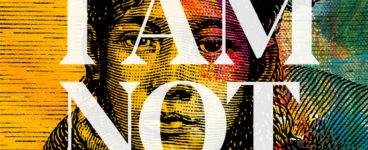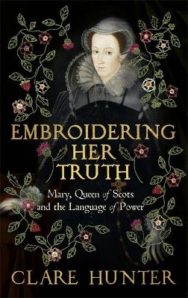‘Embroidered textiles became a currency of not just women’s agency but their mutual support and correspondence’
Mary Queen of Scots is one of the most documented women in Scotland’s history, and yet there is still much to know and learn. Clare Hunter talks to BooksfromScotland about her new biography Embroidering Her Truth, blending history, politics and memoir to tell the story of a queen in her own voice.
Embroidering Her Truth: Mary, Queen of Scots and the Language of Power
By Clare Hunter
Published by Sceptre
Could you tell us a little of what to expect from the book?
I hope that, despite all the many books written about Mary, Queen of Scots, the book can still surprise and offer new insights into Mary’s life and reign. Focussing on the Scottish queen’s material world allowed me to delve further into the sixteenth century culture that both shaped and restrained her: the glory of the late French Renaissance where textiles harboured the spirit of the age and declared status and ambition; the stern aesthetic of the Calvinist Scotland Mary returned to in 1561 where the decorative arts were increasingly viewed with suspicion and the embrace of embroidery amongst elite women as a potent form of self-expression and female influence. The book follows a chronological path as a material biography of Mary, but it is peppered with personal anecdotes that connect us, and me, to her experiences as a woman and as an embroiderer.
It’s such a unique lens to view power and history, where we usually hear about war and battles. Can you tell us a little more about how women exercised different forms of power through the needle?
In the sixteenth century there were an unprecedented number of women wielding political and cultural power in the courts of Europe as queens, regents and mistresses. This coincided with an expansion of trade which brought them to finer materials suited to embroidery – slender needles, silk threads, luxury cloth. For these elite and educated women embroidery became a form of writing, a way to visually assert their presence, curate their botanical and heraldic knowledge and, for some like Mary, conserve their personal testimonies for posterity. As well as creating textiles these women gifted, displayed, commissioned and exchanged them. Embroidered textiles became a currency of not just women’s agency but their mutual support and correspondence.
Is there a reason you wanted specifically to focus on Mary, Queen of Scots?
When I was writing my first book, Threads of Life about the emotional, social and political significance of needlework, Mary, Queen of Scots was the central figure in my chapter on power. My research for that chapter uncovered a rich source of archival material – treasurers’ accounts, inventories, state papers – that begged further examination. I embarked on an M.A. in Historical Research at the University of Stirling with Mary’s material world as my subject. What I learned inspired me to continue and led to the book but my focus changed. The book, while using textiles as the wellspring for exploring Mary, reveals sixteenth century women’s court culture and their alternative forms of agency in a way that I didn’t expect.
Mary’s court took inspiration from the Renaissance culture she experienced in France. Though the Stuart kings before Mary had also embraced the value of culture in society, how would you characterise Mary’s role in the cultural exchange between Scotland and the continent?
As you say cultural exchange between Scotland and the continent was well underway before Mary took up her throne. The Auld Alliance between Scotland and France had seen the criss-crossing of scholars, ecclesiastics, merchants, musicians and myriad others to and from the Scottish court. James IV, Mary’s grandfather and her father James V, as well as her mother, Mary de Guise, reigned over a court that was cosmopolitan in its design and entertainments with African drummers, Italian musicians and French tailors key players in their households. Mary continued the connections but her predominant influence was French, a culture she cleaved to. In some ways, because of her sex and her role as queen once back in Scotland, she had less opportunity to travel and discover for herself the cultural trends emerging in Europe. She had to depend on her ambassadors and advisors for cultural intelligence: David Rizzio her Italian secretary, the Archbishop Beaton, her ambassador in Paris, her Guise family in France and her sister-in-law, Elisabeth de Valois who had married Philip II of Spain.
Could you tell us a little about the symbolic meanings behind some of the visual motifs in textiles at this time? How did this language develop and become recognised?
The mid-sixteenth century was a pre-literate age when print was still in its infancy. People communicated in a highly developed sophisticated code of visual imagery. The court culture of the day delighted in visual conundrums, in emblematic ciphers and layered visual clues that could signal, not just lineage and allegiance, but knowledge, experiences, emotions and political aspiration. Inspired by classical and biblical texts, fables and proverbs, heraldry and the underlying symbolism of flora and fauna which had evolved over time, those who were educated could tease out complex visual messages much as today we unravel cryptic crosswords. Moreover, in courts where foreign brides and their entourages were common, where ambassadors from other lands congregated, a common visual language was expedient and more inclusive.
Mary turned to embroidery during her period of captivity before her execution. Could you tell us how she used her needlework while she was a prisoner?
As a captive in England for so many years, with her correspondence intercepted and, at times, censored and with her meetings with others restricted and monitored Mary, Queen of Scots had limited means to voice her own, unedited story. In captivity she took up embroidery with alacrity using it as an alternative form of communication: to express her feelings of loss – both personal and political; to document her conflicted relationship with her captor, Elizabeth I of England; and to assert her rightful place as a mother and Scotland’s queen. The bed hangings she sewed for her son, James who would become James VI of Scotland and I of England, were redolent with images of destruction, capture and decline. While they haven’t survived we are lucky to have a detailed description of their content. Mary also used her needlework to smuggle out messages to her supporters. She embroidered a cushion as a gift for the Duke of Norfolk who was her suitor and co-conspirator in a plot to overthrow Elizabeth I. It featured the pruning of an infertile vine – a reference to the Virgin Queen – and boasted symbols of Catholic triumph. The cushion was cited in the Duke’s trial for treason and he was executed. Mary never embroidered anything as treasonable again.
There seems to be a concerted effort at the moment to highlight the untold stories, particularly stories from the women in Scottish history. I’m thinking of Sara Sheridan’s book Where are the Women? And the Witches of Scotland project by Claire Mitchell and Zoe Venditozzi. Your book very much fits into this moment too, though it seems extraordinary that even when a woman is the most powerful figure in a country, they are still silenced, How do you recommend we continue to shine a light on those unheard voice from all walks of life? Are there other figures from history you’d like to explore?
What is interesting now is that stories of women’s lives are being excavated by means other than written text. For women of past centuries the little that was recorded of them was penned by men or curated by male historians or biographers who had scant interest in or knowledge of women’s culture. Much of what women wrote of themselves was discarded leaving little behind to recreate their personalities and their narratives. As more women enter the field of historical research they have turned ingenious to discover more about women of the past: court records, household inventories, wills and tangible heirlooms like textiles. Such evidence of women’s lives helps to piece together more of their stories, however fragmentary.
As to who I might write about in the future, after four years of researching and writing about Mary, Queen of Scots my appetite for historical research is somewhat sated. You only need to look at The New Biographical Dictionary of Scottish Women to realise how many Scottish women’s stories still need to be told more fully. There are some who have clutched at my sleeve more than others but, as yet, I have no idea who will eventually win my heart.
Embroidering Her Truth: Mary, Queen of Scots and the Language of Power by Clare Hunter is published by Sceptre, priced £20.00.
ALSO IN THIS ISSUE

 I Am Not Your Eve: A Q and A with Devika Ponnambalam
I Am Not Your Eve: A Q and A with Devika Ponnambalam
‘The book gives a voice to a girl forgotten by history’














